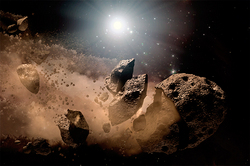 Another amazing project launches the U.S. space Agency. NASA experts are going to look for gold and other minerals on asteroids. For this purpose already created by the original telescope, and the project cost is estimated at several million dollars. Another amazing project launches the U.S. space Agency. NASA experts are going to look for gold and other minerals on asteroids. For this purpose already created by the original telescope, and the project cost is estimated at several million dollars.
As they say in the article, published in the journal SPIE Newsroom, engineers from Vanderbilt University commissioned NASA has created a model of an extraordinary telescope, whose main purpose is "sounding" the depths of the asteroid and search there for gold and other minerals using galactic gamma radiation. This gamma ray telescope will peer into the subsurface layers of rock on asteroids, using cosmic rays reaching us from interstellar medium.
"Mission to Mars, the moon, mercury and Vesta are equipped with low-resolution spectrometers, which require a large amount of research time and costs for mapping minerals on the surface of the studied celestial bodies. Our system will measure the proportion of substances in the subsurface of these bodies with extremely high precision and extremely small cash," convinces 1 of the authors of the draft Cavan Stassun from the Institute of Vanderbilt in Nashville.
As the scientist explains, all airless bodies of the Solar system is actually continuously bombarded with "galactic" charged particles accelerated to relativistic velocities. When they collide with atoms on the surface of asteroids and moons, they generate a flow of other particles that penetrate in the thickness of rocks, and, moreover, slam into atoms of gold and other components in their interior, giving rise to a flux of gamma-quanta.
How to convince scientists, if the thread "catch" and analyze his range, then you can quite accurately know the chemical composition of the asteroid or planet and to estimate its "profitability" based on the belief mining. Besides all this, the same scenario will facilitate and accelerate the task of finding celestial bodies, but will also help planetary scientists to better understand birth of the Solar system.
sections: Society, World News
|